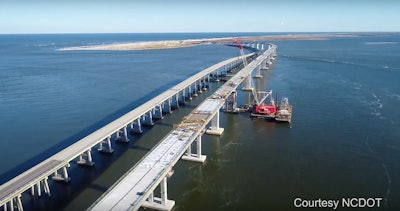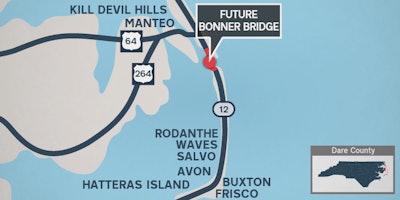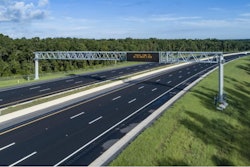 A view of the replacement Bonner Bridge (right) in November beside the current bridge. Credit: NCDOT
A view of the replacement Bonner Bridge (right) in November beside the current bridge. Credit: NCDOTDrivers to and from Hatteras Island will soon be able to travel over North Carolina’s first bridge made of stainless reinforcing steel.
The design of the new span – to replace the Herbert C. Bonner Bridge on N.C. 12 over the Oregon Inlet between Hatteras and Bodie islands on the Outer Banks – is intended to withstand saltwater corrosion as well as hurricanes. It has an expected life of 100 years, according to the N.C. Department of Transportation. The concrete-reinforcing stainless steel is also expected to reduce maintenance costs.
 Credit: NCDOT
Credit: NCDOTThe $252 million bridge is 2.8 miles long and will rise 90.5 feet at its highest point. The current bridge was built in 1963 and designed for only 30 years. It will be partially demolished after the new bridge opens, but about 1,000 feet on the south side will remain for pedestrian use, NCDOT says. Material from the demolished bridge will be used to create artificial reefs, according to NCDOT.
The new bridge was scheduled to open in December, but the 2018 hurricane threats to the area have delayed the opening until February or March, according to The Associated Press.
Along with being reinforced by stainless steel, the concrete will be thicker, denser and less permeable than the current bridge, also as a means of withstanding the elements. The pilings are longer and have been driven deeper into the inlet floor to prevent issues with scour that have caused problems with the current bridge.
“The new bridge is designed to stand strong to a 100-year worst-case scenario for scour,” NCDOT says.
 Credit: NCDOT
Credit: NCDOTBoaters will also see improvements. The high-rise portion spans 3,500 feet and has seven navigational openings that are each about 300 feet wide. The current bridge has only one opening for boats, and it is only 130 feet wide. The two-lane bridge will also have 8-foot-wide shoulders, which the current bridge does not have.
The bridge has been a long time coming – planned for 30 years by the NCDOT, the agency says. The design-build contract with PCL Civil Constructors was approved in 2011, but court battles over environmental concerns delayed construction until March 2016.
See below to watch an NCDOT video of the project:










